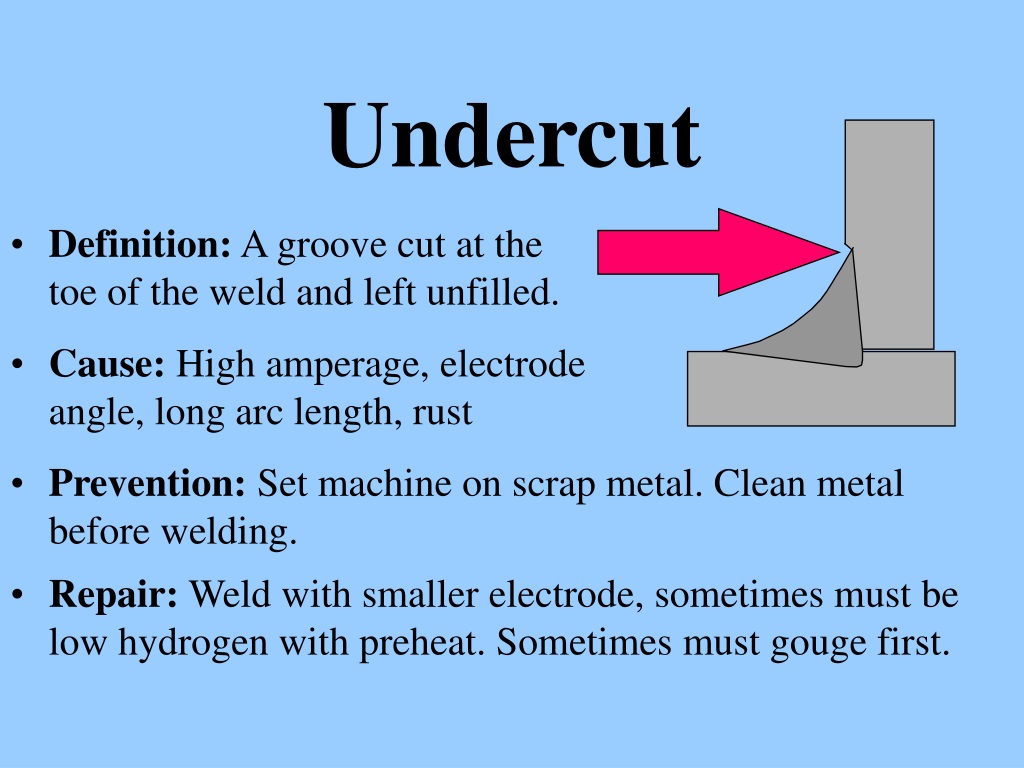Expert Approaches for Preventing Weld Undercut Properly
Expert Approaches for Preventing Weld Undercut Properly
Blog Article
Mastering the Art of Welding: Exactly How to Avoid Undercut Welding Issues for Flawless Manufacture Outcomes
Performance and precision are critical on the planet of welding, where also the least blemish can endanger the structural stability of a fabricated item. One usual obstacle that welders face is undercutting, a problem that can compromise a weld joint and lead to costly rework. By recognizing the origin causes of undercut welding and implementing effective methods to avoid it, welders can boost their craft to new degrees of excellence (Preventing weld undercut). In the quest of flawless construction results, mastering the art of welding to prevent undercut problems is not simply a skill but a need for those making every effort for perfection in their work.
Understanding Undercut Welding

To avoid undercut welding, welders ought to guarantee proper welding criteria, such as readjusting the current, voltage, traveling rate, and preserving the right electrode angle. Furthermore, making use of the appropriate welding strategy for the certain joint setup is important. Utilizing weaving motions or backstepping strategies can assist ensure proper weld metal deposition and decrease the likelihood of undercut formation. Regular examination of welds throughout and after the welding procedure is likewise critical to capture any kind of undercut early and make essential changes to avoid additional problems. Preventing weld undercut. By understanding the reasons of undercut welding and executing safety nets, welders can achieve top notch, structurally audio welds.
Reasons For Undercut in Welding
Recognizing the aspects that add to undercut in welding is necessary for welders to produce high-grade, structurally sound welds. Undercutting takes place when the weld steel does not appropriately load the groove developed between the base steel and the previously transferred weld metal. Several factors can cause undercut in welding. One usual cause is extreme warmth input. Welding at heats for extensive periods can lead to the base metal thawing more than preferred, causing damage. Insufficient welding present or incorrect welding rate can additionally contribute to undercut. Not enough current might not provide sufficient heat to melt the base and filler metals appropriately, while excessive speed can stop correct fusion, creating undercut. In addition, incorrect electrode angles or wrong torch manipulation methods can create locations of low weld metal deposition, promoting undercut. Recognizing these reasons and applying correct welding strategies can help avoid damaging problems, making sure strong and long lasting welds.
Techniques to stop Undercutting

To reduce the danger of damaging in welding, welders can utilize strategic welding strategies aimed at improving the high quality and integrity of the weld joints. One reliable technique is to adjust the welding parameters, such as voltage, current, and travel speed, to make certain proper heat input and deposition. Preserving an ideal electrode angle and making certain consistent traveling rate can likewise help avoid undercut. Furthermore, using the appropriate welding technique for the particular joint configuration, such as weave or stringer grains, can add to reducing damaging. Preventing weld undercut.
Furthermore, proper joint prep work, including ensuring clean base materials complimentary of impurities and utilizing the suitable welding consumables, is vital in preventing undercut flaws. Using back-step welding techniques and managing the weld grain profile can additionally help distribute warmth evenly and reduce the danger of undercut. Regular inspection of the weld joint during and after welding, along with executing quality control steps, can aid in attending to and finding damaging issues without delay. By applying these techniques faithfully, welders can accomplish perfect construction results with marginal undercut flaws.
Significance of Appropriate Welding Criteria
Picking and maintaining proper welding parameters is crucial for attaining successful welds with minimal problems. Welding parameters describe variables such as voltage, present, take a trip rate, electrode angle, and securing gas flow price that directly affect the welding process. These parameters must be carefully changed based on the kind of material being bonded, its density, and the welding method used.
Proper welding specifications guarantee the correct amount of warmth is put on thaw the base metals and filler product uniformly. If the criteria are established also high, it can bring about extreme warm input, causing burn-through, spatter, or distortion. On the other hand, if the criteria are too low, incomplete combination, absence of infiltration, or undercutting may happen.
Quality Control in Welding Operations

Verdict
To conclude, grasping the art of welding requires a thorough understanding of undercut welding, its reasons, and techniques to stop it. By making sure appropriate welding criteria and carrying out quality guarantee methods, remarkable construction results can be achieved. It is essential for welders to regularly aim for quality in their welding operations to avoid undercut concerns and create top quality welds.
Undercut welding, a typical problem in welding procedures, occurs when the weld steel doesn't effectively fill the groove and leaves a groove or clinical depression along the original source the welded joint.To stop undercut welding, welders should make sure proper welding specifications, such as readjusting the present, voltage, traveling speed, and preserving the proper electrode angle. Inadequate welding present or wrong welding speed can likewise add to undercut.To reduce the threat of undercutting in welding, welders can utilize critical welding strategies intended at boosting the quality and stability of the weld joints.In verdict, understanding the art of welding requires a complete understanding of undercut welding, its reasons, and weblink techniques to prevent it.
Report this page